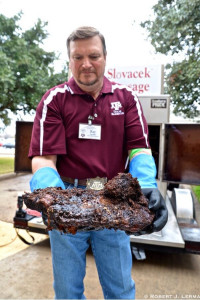Hey, everyone: I'm mostly a pork man, but after trying (and loving) beef ribs I'm looking to take on some larger red meat cooks. I think a good place to start would be chopped/pulled beef, and then progress to brisket.
The main problem for me is sourcing the meat: Italian beef is not graded, it's almost universally leaner than Select, and cut and named very differently to boot. Past experiences in big chains and large butchers were dismal.
The good news is that the guy I buy my pork from, who raises great pigs (strictly free-range, and he grows everything he feeds them too), also butchers a steer every month or so. I've tried his ribeyes (and the aforementioned short ribs), and the meat is tasty if very lean, so he's probably my best bet.
Do you think it makes sense to try to cook a really, really lean chuck into chopped beef or am I going to end up with nicely-barked leather and sawdust? Is there a specific part of the chuck that's usually fattier and therefore better suited to my ends, and ideally of manageable size?
If there is, how do I explain him exactly what I want? Are there drawings/diagrams I could print out? It was already hard enough getting him to understand that I wanted two bone-in short ribs together (and that conversation probably left him with the lasting impression that I'm mad and possibly dangerous).
What about brisket? Is it worth trying to BBQ a packer with the leanest flat in the world or am I better off leaving it for pastrami? Do I have a snowball's chance in the Italian summer to be able to explain the right cut? (Picture two Italian hillbillies standing in a field arguing and gesticulating around a piece of paper...)
The main problem for me is sourcing the meat: Italian beef is not graded, it's almost universally leaner than Select, and cut and named very differently to boot. Past experiences in big chains and large butchers were dismal.
The good news is that the guy I buy my pork from, who raises great pigs (strictly free-range, and he grows everything he feeds them too), also butchers a steer every month or so. I've tried his ribeyes (and the aforementioned short ribs), and the meat is tasty if very lean, so he's probably my best bet.
Do you think it makes sense to try to cook a really, really lean chuck into chopped beef or am I going to end up with nicely-barked leather and sawdust? Is there a specific part of the chuck that's usually fattier and therefore better suited to my ends, and ideally of manageable size?
If there is, how do I explain him exactly what I want? Are there drawings/diagrams I could print out? It was already hard enough getting him to understand that I wanted two bone-in short ribs together (and that conversation probably left him with the lasting impression that I'm mad and possibly dangerous).
What about brisket? Is it worth trying to BBQ a packer with the leanest flat in the world or am I better off leaving it for pastrami? Do I have a snowball's chance in the Italian summer to be able to explain the right cut? (Picture two Italian hillbillies standing in a field arguing and gesticulating around a piece of paper...)





Comment